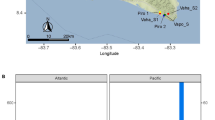Abstract
This study investigates the molecular, carbon, and hydrogen isotope compositions of n-alkanes in eight pairs of a holoparasitic plant (Cuscuta chinensis) and its hosts. It is unexpected that C. chinensis has a higher concentration of n-alkanes than its hosts in seven of the eight pairs, and it is preferentially dominated by n-C29 alkane (representing > 75% of the total n-alkanes). In addition, the δ13C values of C29 alkane in C. chinensis are less negative (avg. 1.8 ‰) than those in the hosts, while the δ2H values of C29 alkane are more negative in C. chinensis (the difference averages 48 ‰). We propose that the 2H-depletion of n-alkanes in the stem parasite C. chinensis may result from the utilization of stem water with less influence from evapotranspiration or the use of newly synthesized carbohydrates which is 2H-depleted relative to stored sugars. These results highlight the importance of plant nutrient status on the molecular and isotopic compositions of leaf waxes, which shed light on the (paleo)ecological potential of leaf wax δ2H values.
Similar content being viewed by others
References
Badeck F W, Tcherkez G, Nogués S, Piel C, Ghashghaie J (2005). Post-photosynthetic fractionation of stable carbon isotopes between plant organs—a widespread phenomenon. Rapid Commun Mass Spectrom, 19(11): 1381–1391
Bush R T, McInerney F A (2013). Leaf wax n-alkane distributions in and across modern plants: Implications for paleoecology and chemotaxonomy. Geochim Cosmochim Acta, 117: 161–179
Cormier M A, Werner R A, Sauer P E, Gröcke D R, Leuenberger M C, Wieloch T, Schleucher J, Kahmen A (2018). 2H-fractionations during the biosynthesis of carbohydrates and lipids imprint a metabolic signal on the δ2H values of plant organic compounds. New Phytol, 218(2): 479–491
Cormier M A, Werner R A, Leuenberger M C, Kahmen A (2019). 2H-enrichment of cellulose and n-alkanes in heterotrophic plants. Oecologia, 189(2): 365–373
Eglinton G, Hamilton R J (1967). Leaf epicuticular waxes. Science, 156(3780): 1322–1335
Eglinton T I, Eglinton G (2008). Molecular proxies for paleoclimatology. Earth Planet Sci Lett, 275(1–2): 1–16
Ehleringer J R, Cook C S, Tieszen L L (1986). Comparative water use and nitrogen relationships in a mistletoe and its host. Oecologia, 68(2): 279–284
Gleixner G, Danier H J, Werner R A, Schmidt H L (1993). Correlations between the 13C content of primary and secondary plant products in different cell compartments and that in decomposing basidiomycetes. Plant Physiol, 102(4): 1287–1290
Kahmen A, Dawson T E, Vieth A, Sachse D (2011). Leaf wax n-alkane δD values are determined early in the ontogeny of Populus trichocarpa leaves when grown under controlled environmental conditions. Plant Cell Environ, 34(10): 1639–1651
Kahmen A, Hoffmann B, Schefuß E, Arndt S K, Cernusak L A, West J B, Sachse D (2013). Leaf water deuterium enrichment shapes leaf wax n-alkane δD values of angiosperm plants II: observational evidence and global implications. Geochim Cosmochim Acta, 111: 50–63
Koch K, Ensikat H J (2008). The hydrophobic coatings of plant surfaces: epicuticular wax crystals and their morphologies, crystallinity and molecular self-assembly. Micron, 39(7): 759–772
Li C, Fu Z, Wang Y, Tang H, Yan J, Gong W, Yao W, Criss R E (2019). Susceptibility of reservoir-induced landslides and strategies for increasing the slope stability in the Three Gorges Reservoir Area: Zigui Basin as an example. Eng Geol, 261: 105279
Liu J, An Z (2020). Comparison of different chain n-fatty acids in modern plants on the Loess Plateau of China. Front Earth Sci.
Mishra J S (2009). Biology and management of Cuscuta species. Indian J Weed Sci, 41: 1–11
Newberry S L, Kahmen A, Dennis P, Grant A (2015). n-Alkane biosynthetic hydrogen isotope fractionation is not constant throughout the growing season in the riparian tree Salix viminalis. Geochim Cosmochim Acta, 165: 75–85
O’Leary M H (1981). Carbon isotope fractionation in plants. Royal Society of New Zealand Wellington New Zealand, 20(4): 553–567
Pu Y, Jia J H, Cao J C (2018). The aliphatic hydrocarbon distributions of terrestrial plants around an alpine lake: a pilot study from Lake Ximencuo, Eastern Qinghai-Tibet Plateau. Front Earth Sci, 12(3): 600–610
Sachse D, Billault I, Bowen G J, Chikaraishi Y, Dawson T E, Feakins S J, Freeman K H, Magill C R, McInerney F A, Van der Meer M T, Polissar P, Robins R J, Sachs J P, Schmidt H, Sessions A L, White J W C, West J B, Kahmen A (2012). Molecular paleohydrology: interpreting the hydrogen-isotopic composition of lipid biomarkers from photosynthesizing organisms. Annu Rev Earth Planet Sci, 40(1): 221–249
Sessions A L (2016). Factors controlling the deuterium contents of sedimentary hydrocarbons. Org Geochem, 96: 43–64
Tipple B J (2013). Capturing climate variability during our ancestors’ earliest days. Proc Natl Acad Sci USA, 110(4): 1144–1145
Zang J, Lei Y, Yang H (2018). Distribution of glycerol ethers in Turpan soils: implications for use of GDGT-based proxies in hot and dry regions. Front Earth Sci, 12(4): 862–876
Zhao B, Zhang Y, Huang X, Qiu R, Zhang Z, Meyers P A (2018). Comparison of n-alkane molecular, carbon and hydrogen isotope compositions of different types of plants in the Dajiuhu peatland, central China. Org Geochem, 124: 1–11
Ziegler H (1995). Deuterium content in organic material of hosts and their parasites. In: Schulze E D, Caldwell M, eds. Ecophysiology of Photosynthesis. Ecological Studies, Vol 100. Berlin: Springer, 393–408
Acknowledgements
This work was supported by the National Natural Science Foundation of China (Grant No. 41877317), and the fundamental research funds for the central universities (Nos. CUGCJ1703, CUGQY1902). We thank two anonymous reviewers for their suggestions that improved the quality of this paper.
Author information
Authors and Affiliations
Corresponding author
Rights and permissions
About this article
Cite this article
Yang, X., Huang, X. Different patterns of molecular, carbon and hydrogen isotope compositions of n-alkanes between heterotrophic plant and its hosts. Front. Earth Sci. 14, 783–788 (2020). https://doi.org/10.1007/s11707-020-0829-x
Received:
Accepted:
Published:
Issue Date:
DOI: https://doi.org/10.1007/s11707-020-0829-x




